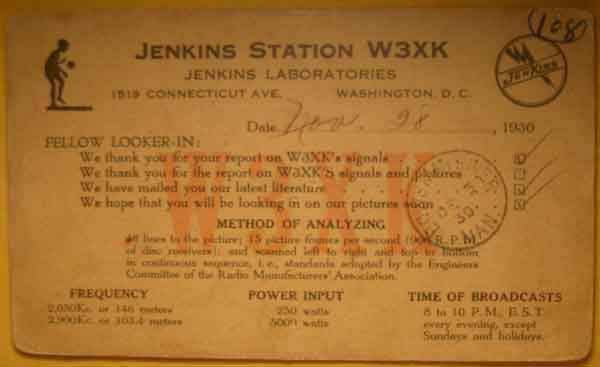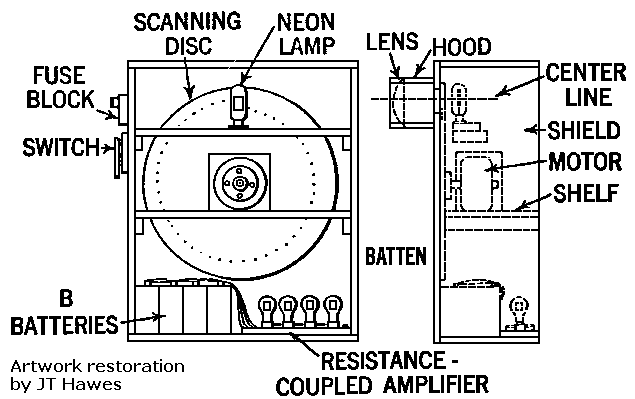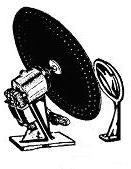Origin of Mechanical Television
The first mechanical television systems grew out of repeating telegraphs and clockwork. These early systems evolved over some 80 years. Machines capable of displaying moving pictures appeared by the middle 1920s. The work of the twentieth-century inventors involved improvements to Paul Nipkow's 1884 television patent. Nevertheless, some historians attribute television's invention to a Scot, John Logie Baird of England. Others credit U.S. inventor Charles Jenkins. Most historians overlook concurrent work by U.A. Sanabria in the U.S. In the mid-1920s, all three demonstrated operating mechanical TV apparatuses. Inventors in several countries produced working devices at about the same time, but to little fanfare.
|
|
|
Compound Invention
Most early television devices emerged independently, yet during the same period. Happenstance? Hardly. Prior inventions provided all TV's building blocks, making parallel development both possible and likely. Television is a compound invention. Crediting the last contributor for the entire invention distorts the truth. We might as well celebrate the man who drove the last spike as the railway's father.
Stations
Pioneering telecasts originated all over the world. For the public, the mechanical TV craze really started in 1928. That year, several U.S. stations came on the air. Others followed over the next few years. Boston, Chicago, New York and Washington, D.C. all had television transmitters. Today, few people remember educational programming from smaller towns: Iowa City, Lawrence, Kansas and West Lafayette, Indiana. Some experimental stations, such as Chicago's W9XAO and W9XAP, and New York's W2XAB, concentrated on programming. These stations followed published schedules. Other stations, such as W2XBS, RCA’s New York flagship, concentrated on technical experiments.

|
QSL postcard from station W3XK, 1930 (First licensed U.S. TV station). Viewer was in Manitoba, Canada. Mechanical TV station was in Washington, DC, USA. Card confirms viewer's written reception report. (Courtesy of R.L. Dean) |
Beginning of Standards
Local Standards. U.S. stations of the time had at best local scanning standards and at worst no standards. That is, a television receiver for one station often couldn't reproduce the picture from another station. In those days, programs could easily travel out of town on the sky waves. Yet the lack of standards prevented many remote viewers from enjoying the shows. In October 1928, the RMA (Radio Manufacturers' Association) discussed the standards problem. The organization recommended two regional standards, 60 and 48 lines. In both standards, the scanning direction is from left to right and top to bottom. The frames-per-second rate (fps) is 15. The RMA didn't recommend a sync method. (See Abramson, The History of Television, 1880-1941, p. 128. Also Udelson, The Great Television Race,pp. 45-46.) Manufacturers of the day employed various sync methods. The most common were phonic or cogged wheels, synchronous motors and manual sync. Such methods continued for a few years, with automatic methods gradually replacing manual methods.
Regional Standards
East Coast vs. Midwest. The 60-line TV format came from Frank Conrad at Westinghouse. In this format, the mechanical scanner paints a new frame 20 times per second. The frames are horizontal rectangles, with a width to height ratio of six to five. RCA adopted 60 lines and abandoned 48 lines, the standard of Jenkins and General Electric's Ernst Alexanderson. The 60-line format became the regional standard of the U.S. East Coast. After RCA began transmitting with 60 lines, most stations on the U.S. Eastern Seaboard followed suit. Even Jenkins' W2XCR, his Jersey City, New Jersey outlet transmitted 60-line, 20 fps pictures. Midwestern stations ignored the RMA and adopted their own regional standard. This 45-line, 15 fps standard is a 1929 invention of Ulises Sanabria. At the time, Sanabria was the chief engineer for Western Television Corporation. The Sanabria standard is unique because of its triply interlaced scanning. Interlacing drastically reduced the flicker that plagues other mechanical TV methods.
West Coast. In 1931, Don Lee Broadcasting went on the air in Gardena, California, near Los Angeles. The Don Lee station W6XAO transmitted 80-line, 15 fps television pictures. The equipment was mechanical, and the programming source was film. The station reached out to amateurs by publishing receiver-building instructions.
Station offered discs. Because 80-line scanning discs were nearly impossible to make without machine tools, the station also sold the discs. (Imagine that! $6.50 each!) Harry Lubcke, the chief engineer and designer of much of the equipment, was only 24. His television pedigree was impeccable, though. He'd previously worked for Philo Farnsworth, the child prodigy who had invented the image dissector camera tube. Soon, Lubcke converted W6XAO to electronic equipment.
Shortwave Television Band
Broader Bandwidth for Television. The 45, 60, and 80-line transmissions were too broad for standard, medium-wave (AM band) channels. In 1929, the FRC (Federal Radio Commission, predecessor of the FCC) responded to the situation. The FRC moved television to the 160-meter shortwave band. Channels in this band were broad enough for pictures of up to 70 lines at 20 fps. (Or more conservatively, 60 lines with ample guard bands.)
Shortwave TV
DX Reception. Receivers hundreds of miles from a station could pick up shortwave television pictures. For ham radio operators, distance (DX) television reception became the rage. Despite ghost images and fading, the low-resolution pictures created a sensation.
Homemade Television Equipment. Amateur radio operators and experimenters even built their own sets. (In fact, besides set construction, these volunteers also pioneered equipment development and testing. Some hams even transmitted mechanical television pictures.) Very few households could afford manufactured television receivers. Instead, bars, hotels and department stores displayed working sets.

| Line drawings of a homemade mechanical TV receiver. From The A.B.C. of Television by Raymond Francis Yates, 1929, p. 204. |
End of the Craze
Fade to Black. For many reasons, the public didn’t long adopt mechanical television. After 1931 or 1932, articles about television in popular technology magazines became less frequent. The Great Depression worsened. Stations began shutting down. Manufacturers such as Majestic, Western, de Forest and Jenkins went broke. By 1934, most United States stations left the air. Thirty-line transmission by the BBC continued until 1935. British electronic television broadcasting succeeded it in 1936. What caused the end of the mechanical TV craze? Most historians cite two reasons...
- Poor picture quality prevented mechanical TV from providing "entertainment value."
- Mechanical devices can't produce pictures with over 60 lines of resolution.
Both of these notions seem plausible, but both are mistaken. See our “Demise of Mechanical TV” page for the real reasons.
Go to Page: 1 2 3 4 5 6 Next

Page Contents
- Origin of Mechanical Television
- Compound Invention
- Stations
- 1930 TV QSL
- Beginning of Standards
- Regional Standards
- TV Band
- Shortwave TV
- Homemade TV
- End of Craze
- Mechanics